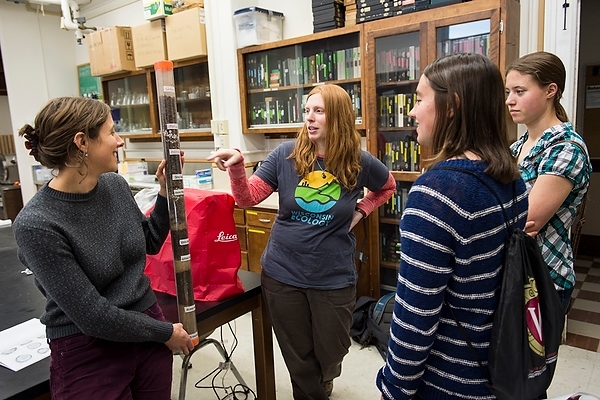In its first year, BioHouse brings opportunity for students in science

Undergraduates Kelly Vanderloop (far right) and Christina McNerney (right) listen to graduate students Kristin Michels (center) and Rachel Brunner (left) describe elements of a soil core sample in a lab tour for BioHouse residents.
Rachel Brunner laid the old notebooks out on the black lab table. Frayed around the edges, pages yellowed, the notes they contain are a treasure trove for the University of Wisconsin–Madison graduate student, who studies the effects of climate change in the cloud forests of Maui.
Christina McNerney and Kelly Vanderloop, both freshmen at UW–Madison, collected around the notebooks, examining the neat and meticulous handwriting penned by the long-gone graduate student they once belonged to, decades ago.
The two budding young scientists were visiting the lab as part of a tour hosted by their mentors at BioHouse, the campus residential learning community in Cole Hall where they live, study and play.
BioHouse is the newest of 10 UW–Madison residential learning communities — clusters of students in residence halls who choose to live with others active in a common interest area — three of which are designed for students interested in science. Focused on biological sciences, BioHouse — in partnership with WISCIENCE and University Housing — opened in fall 2014 and McNerney and Vanderloop are among its first 66 residents.
“Students in the sciences need to understand all fields in the biosciences and collaborate across interdisciplinary fields. We are trying to give students a broader perspective.”
Aaron Miller
Brunner and her lab mate, Kristin Michels, are among the first BioHouse graduate student mentors, who lead weekly seminar discussion sections with the undergraduates, organize science-focused events and serve as resources for the younger students.
“What do you think of when you hear the word paleo?” Michels asked McNerney and Vanderloop, as she and Brunner led them through their paleoecology lab, headed by botany Professor Sara Hotchkiss.
“Old,” the students replied in near unison.
Indeed, like the historic notebooks Brunner is using to complement her current data, the lab relies on the natural historical record of soils, spores and other elements to study ecological change over time.
Vanderloop and McNerney both found the tour right up their alley.
“I like archaeology,” said Vanderloop, whose major is currently undecided.
“Technically, I am pre-med, but I like history, too,” said McNerney, a biochemistry major. “That’s why I love it here. I can do anything I want.”
Both students joined BioHouse because they wanted to be surrounded by like-minded peers and have access to unique life-science-focused experiences and opportunities, such as the graduate student-led lab tours and visits to UW Hospital and Clinics.
“I knew I wanted to do something in the sciences and if I was with people with the same interests, I’d find something to focus on,” said McNerney, as Vanderloop piped in that their BioHouse peers are all in the same classes and can study together.
At BioHouse, located in Cole Residence Hall, the students attend a weekly seminar — headed by Jonathan Pauli, faculty director and professor of forest ecosystem ecology — called Biology in the 21st Century.
“It brings in speakers doing research on everything from the microbiology of the gut, to forest fires and health,” says Aaron Miller, the BioHouse coordinator who is also with WISCIENCE.
At UW–Madison, roughly a quarter of incoming students each year express interest in the biological sciences. BioHouse was designed to … help them integrate each of their courses, from chemistry to math and biology.
This interdisciplinary nature is a large part of the appeal of BioHouse.
“Students in the sciences need to understand all fields in the biosciences and collaborate across interdisciplinary fields,” says Miller. “We are trying to give students a broader perspective.”
At UW–Madison, roughly a quarter of incoming students each year express interest in the biological sciences. BioHouse was designed to give them exposure to science early on and to help them integrate each of their courses, from chemistry to math and biology.
Approximately 80 percent of the students at BioHouse this year were recruited from WISCIENCE’s MadBiology Boot Camp, a crash course in science for underrepresented undergraduates and first-generation college students. Miller says the boot camp will be incorporated into BioHouse in coming years.
“They have similar issues and successes; the mindset is pretty special,” says Miller. “Knowing they’re in a welcoming community helps.”
The gender balance at BioHouse is roughly split between men and women, and because it’s the first year, the students are primarily freshmen, with a few sophomores mixed in. BioHouse will grow as these students mature and begin to serve as mentors for new residents in years to come.
And as they do, they will continue to learn and enjoy the benefits that living in a learning community affords, like last fall’s hikes, nature walks, on-campus science lectures, Badger watch parties, monthly community meals and more. The students are encouraged to share their triumphs and trials through weekly reflections.
“They’re very simple, but nice because they make you think,” says Vanderloop, just before she and McNerney, BioHouse comrades and partners in science, walked back down Bascom Hill to their learning community on the lake.




